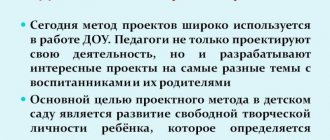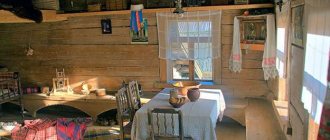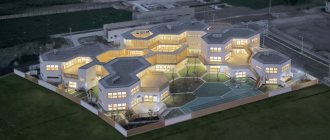Project activities in preschool educational institutions: approaches, content
Currently, in preschool education, traditional education is being replaced by developmental education, which is aimed at developing creative abilities , developing cognitive interest and the need for active creative activity in preschoolers. The project method fully complies with the requirements of the Federal State Educational Standard for preschool education and can be implemented both within the framework of the cognitive development of preschool children and through the integration of educational areas .
The project method as a set of educational and cognitive techniques that make it possible to solve a particular problem as a result of independent actions of students with the obligatory presentation of these results.
The goal is to develop the creative abilities of the child’s personality, which are determined by the developmental tasks and tasks of the children’s research activities.
Objectives : - teach basic planning; — develop skills in collecting and processing information and materials; — develop creative abilities; - to form a positive attitude towards cognitive, research, creative activities.
Basic requirements for project activities: - the presence of a problem that requires integrated knowledge and a research search for its solution; — practical, theoretical, cognitive significance of the expected results; - independent activity of a preschooler; - use of research methods, i.e. defining the problem, the research tasks arising from it, putting forward a hypothesis for their solution. Discussion of research methods, presentation of final results, analysis of the data obtained, summing up, adjustments, conclusions.
Typology of projects : (according to E. S. Evdokimova “Design technology in preschool educational institutions”) - the dominant activity in the project: research, search, creative, role-playing, applied (practice-oriented), orientation, etc. (research project, game, practice-oriented, creative); — subject-content area : mono project (within one area of knowledge), interdisciplinary project; — the nature of project coordination (leadership from the teacher): direct (rigid, flexible), hidden (implicit, simulating a project participant, typical for telecommunications projects); — number of project participants (individual, pair, group); — duration of the project (short-term (1-2 lessons), medium-term (up to a month), long-term.
A feature of project activities in the preschool education system is that the child cannot yet independently find contradictions in the environment, formulate a problem, or determine a goal (intention). Therefore, in the educational process of a preschool educational institution, project activities are in the nature of cooperation, in which children and teachers of the preschool educational institution take part, and parents and other family members are also involved. Parents can not only be sources of information, real help and support for the child and teacher in the process of working on the project, but also become direct participants in the educational process. In this way, parents can enrich their teaching experience, experience a sense of ownership and satisfaction from their successes and the successes of their child [1]
The specificity of using the project method in preschool practice is that adults need to “guide” the child, help detect a problem or even provoke its occurrence, arouse interest in it and “draw” children into a joint project, without overdoing it with parental care and help. Project activities in kindergarten can be represented as a way of organizing the pedagogical process, based on the interaction between teacher and student, a way of interaction with the environment, step-by-step practical activities to achieve the goal [1].
In a preschool institution there may be [2]: 1. Information projects - aimed at collecting information about some object, familiarizing project participants with this information, analyzing it and summarizing facts intended for a wide audience; — structure of the information project: receiving and processing information, obtaining results, presentation.
An example of an information project can be viewed here.
2. Research projects - a research search is carried out, the results of which are presented in the form of some kind of creative product (newspapers, dramatizations, card indexes of experiences, children's design, cookbook, etc.)
An example of a research project can be viewed here.
3. Role-playing projects are projects with elements of creative games, when children take on the role of fairy tale characters and solve the problems in their own way. 4. Creative projects - as a rule, do not have a detailed structure of joint activities of participants; — creative projects are classified according to the dominant type of creativity: artistic and visual, artistic and speech, artistic and design, theatrical, musical, etc.)
An example of a creative project can be viewed here.
Activities of the teacher : At stage 1 - determines the topic, carries out planning, organizes a subject-development environment, informs parents, studies literature. In the process of joint activities with students, he formulates a problem, helps set a goal, and offers to immediately determine the product of the project; immerses you in a game (plot) problem situation. At stage 2 - helps to divide into groups; helps in solving problems; helps plan activities (where to start). Organizes search and research activities of children. At stage 3 - provides practical assistance to children, creates conditions and motivates children. Monitors and coordinates the project. Records the results of information searches, etc. At stage 4 - preparation for the presentation. Presentation (project defense), evaluation.
Activities of preschoolers : At stage 1 - entering into the problem, “getting used to” the game situation, accepting the task, suggestions and additions to the final product. At stage 2 , children are organized into working groups, assigned directions for collecting material and areas of responsibility. At stage 3 - accumulation, systematization and assimilation of new knowledge, skills, abilities. At stage 4 - preparation for project defense, production of the final product. Presenting the products of your activities to the audience
Structure of the educational project: - name of the project; — authors, coordinators, administrators, project organizers; — general characteristics of the project: project participants, project deadlines, project goals and objectives, project hypothesis, expected results; — stages of the project; — project results, their evaluation, prizes and awards.
Sample topics:
- complex:
“World of Theater”, “Hello, Pushkin!”, “Echo of Centuries”, “Book Week”; - intergroup:
“Mathematical collages”, “The world of animals and birds”, “Seasons”; - creative:
“My friends”, “In our boring garden”, “We love fairy tales”, “The world of nature”, “Rowan berries of Russia”; - group:
“Tales of Love”, “Know Yourself”, “Underwater World”, “Fun Astronomy”; - individual:
“Me and my family”, “Family tree”, “Secrets of grandma’s chest”, “Fairytale bird”; - research:
“The World of Water”, “Breath and Health”, “Nutrition and Health”.
In terms of duration, they can be short-term (one or several lessons), medium-long, long-term (for example, “Pushkin’s Work” - for the academic year).
Approximate scheme for the implementation of the “Family” project (old age)
Sources:
- Kovylyaeva L. A., Tretyakova N. I. Using technology of project activities in teaching preschoolers // Scientific and methodological electronic journal “Concept”. – 2021. – T. 46. – P. 167–175. – URL: https://e-koncept.ru/2016/76508.htm.
- Project activities in preschool educational institutions
- https://doshvozrast.ru/metodich/konsultac04.htm
Colleagues!
Let's think about it...
What place does project activity occupy in preschool education?
Pedagogical technology “Project Method”
Modern conditions for the development of society require a reorientation of education from the assimilation of ready-made knowledge, skills and abilities to the development of the student’s personality, his creative abilities, independent thinking and a sense of personal responsibility, as a moral characteristic of the individual. In such a pedagogical theory of learning, the student becomes a central figure, and his activity acquires an active, cognitive character.
Such a pedagogical technology is the “project method”, where it is not the final result that is important (knowledge becomes outdated, subject to change), but the process of acquiring knowledge itself. In this technology, it is necessary to teach students to study independently and obtain the necessary knowledge, to teach them the ability to adapt to life situations and make independent decisions, to think critically.
The project method, firstly, allows us to solve one of the most pressing problems of modern education - the problem of motivation. Using traditional methods, students cannot be captivated by their studies. Therefore, it is necessary to put before them a problem that is interesting and significant for everyone. For the creative productivity of a project, it is important to formulate tasks that do not have uniform, pre-known solutions.
Secondly, the principles of student-centered learning are implemented, when students can choose a subject to their liking in accordance with their abilities and interests.
Thirdly, by completing projects, students master the algorithm of design and transformation activities, learn to independently search for and analyze information, integrate and apply previously acquired knowledge. As a result, their creative and intellectual abilities, independence, responsibility develop, and the ability to plan and make decisions is formed. Students' creative projects should be prototypes of projects in their future professional activities. By completing them, they gain experience in solving real problems, moving forward towards their goal.
Fourthly, the project method is closely related to the use of the latest computer technologies. This includes email, search engines, electronic conferences, quizzes, and Olympiads. Work on international, all-Russian and regional projects is also of increasing interest. Examples of educational Internet projects are: “Give Life”, “Novgorod Talents”, etc. My students take part in these competitions and win victories.
Consequently, I, as a teacher, have the task of teaching students in such a way that they can quickly and flexibly respond to changing conditions, be able to discover new problems and tasks, and find ways to solve them. Achieving results in fulfilling this task is possible only in the context of implementing an innovative approach to learning, ensuring a transition to a productive and creative level.
The word "project" comes from the Latin "projectus", which means "thrown forward", "protruding", "conspicuous". And in fact, when planning a project, the teacher seems to be looking into the future, imagining something that the student can create or obtain with some effort. The project method in education is a didactic means of activating students’ cognitive activity, developing creativity and at the same time forming certain personal qualities. There are three pillars on which this technology rests: independence, activity, and effectiveness.
The idea of collaborative learning arose at the beginning of the century in the works of American teacher-researchers E. Parkhurst (“Dalton Plan”), J. Devey, W. Kilpatrick (“project method”). This method took shape more clearly in the United States by 1919.
The project method attracted the attention of Russian teachers at the beginning of the 20th century. The ideas of project-based learning arose in Russia almost in parallel with the developments of American teachers. Under the guidance of the Russian teacher S.T. Shatsky in 1905, a small group of employees was organized that tried to actively use project methods in teaching practice.
Today, the project method is being used again, but in an updated form. The main task is to help projects take their proper place in educational practice. It is the understanding and application of this method in a new socio-cultural situation in the light of the requirements for education at the modern stage of social development that allows us to speak of the project as a new pedagogical technology that allows us to effectively solve the problems of a student-oriented approach in training a specialist.
During the design process, he considers the most difficult thing for the teacher to be playing the role of an independent consultant, refraining from giving advice even if the student “goes in the wrong direction.” For a student, difficulties may include: a) setting leading and current (intermediate) goals and objectives; b) finding a way to solve them;
c) making an optimal choice in the presence of alternatives;
d) argumentation of choice; e) comparison of the obtained result with the required one; f) adjustment (if necessary) of the result;
g) an objective assessment of the activity itself and other positions.
If we talk about the project method as a pedagogical technology, then this technology involves a set of research, problem-based methods, creative in their very essence.
Having once tried to work with the project method, they cannot refuse it - this is not the attractive force of this method, but the opportunities that allow students to learn, and teachers to teach without coercion, in a fun and interesting way. I consider the main design goals to be:
1. Contribute to increasing the personal confidence of each participant in project-based learning, his self-realization and reflection. The following becomes possible:
• through experiencing a “success situation” (in class or outside class), not in words, but in action, to feel significant, needed, successful, capable of overcoming various problematic situations
• through awareness of oneself, one’s capabilities, one’s contribution, as well as personal growth in the process of completing a project task.
2. To develop in students an awareness of the importance of teamwork to obtain results, the role of cooperation, joint activity in the process of performing creative tasks; inspire them to develop communication skills. What is important in life is the ability not only to express your point of view, your approach to solving a problem, but also to listen and understand another, sometimes completely opposite to your own.
3. Develop research skills: analyze a problem situation, identify problems, select the necessary information from the literature, conduct observations of practical situations, record and analyze their results, build hypotheses, test them, generalize, draw conclusions. In my teaching practice in art history and world cultural history lessons, I most often use such types of projects as research and creative ones.
This contributes to the actualization of students’ knowledge, skills and abilities, their practical application in interaction with the environment. I would like to show the stages of working on a creative project using the example of the project “The Art of Ancient Rus'.
Table “Algorithm for working on the project “The Art of Ancient Rus'”
| Stages of work on the project | The content of the work | Student activities | Teacher's activities |
| Preparation | — defining the topic and goals of the project; -formation of project objectives; | Discuss the project topic with the teacher and obtain the necessary additional information. Defining the goals and objectives of the project. | I introduce students to the meaning of the project approach and motivate students. I help in defining the goals of the project and supervise the work. |
| Planning | - determination of software for project implementation; - determination of methods for collecting and analyzing information; - determination of ways to present results; -establishment of procedures and criteria for assessing project results. | Formation of project objectives, development and justification of criteria for the success of project activities. | I offer ideas, make suggestions, and observe students’ work. |
| Study | -collection and clarification of information; - identification and discussion of alternatives that arise during the implementation of the project; -selection of the optimal project progress option; - step-by-step implementation of research tasks. | Performs research and works on a project step by step. | I provide consultations and indirectly supervise student activities. |
| Conclusion | -analysis of information; -formation of conclusions. | Analyzes information and draws up a project. | I provide consultations and supervise the design of the project. |
| Project defense and evaluation of its results | -presentation of the project (multimedia presentation); -analysis of the completed project and achieved results | Represents the project, defends a multimedia presentation, participates in collective analysis and evaluation of the project in the form of filling out a project checklist. | I listen and ask questions as an ordinary participant. If necessary, I direct the process of analysis and evaluation of projects, and analyze project checklists. |
The evaluation of creative projects comes not only from me, but also from the group’s opinion and the student’s self-esteem. In the complex of all criteria, an appropriate assessment is given, which is reflected in the project checklist.
Project Checklist Table
| Project stages | What to evaluate | Rating (5-point system) | Project proposals |
| Preparation | - selection and justification of the project; - compliance with the goals and objectives of the project. | ||
| Planning | — quality of information; -quantity and quality of illustrative material. | ||
| Study | - how optimal is the choice of project progress; -compliance with project stages. | ||
| Conclusion | -analysis of artistic samples of the art of Ancient Rus'; -comparative analysis of architectural trends in the art of Ancient Rus'. | ||
| Project protection | -quality of multimedia presentation; - achievement of the set goal. |
In a course on the history of art and culture, the project method can be used as part of the program material in almost any lesson. The topics chosen should be significant, interesting and more complex depending on the student’s preparedness. Creative activity during project work gives students the true joy of learning and communication. When performing project work, which can be presented orally and in writing, it is necessary to adhere, in my opinion, to the following recommendations:
• Firstly, since project work allows students to express their own ideas, it is important not to overtly control and regulate students, it is advisable to encourage their independence.
• Secondly, design work is mostly open-ended, so there cannot be a clear plan for its implementation. In the process of completing project tasks, you can introduce some additional material.
• Third, most projects can be completed by individual students, but the project will be most creative if done in groups. This once again emphasizes the importance and effectiveness of educational collaboration.
Our whole life can be seen as an alternation of different projects. The teacher’s task is to teach the student to plan and successfully implement “their life projects.” After all, for any person, the most significant assessment is public recognition of his success. It is important for a student to receive feedback from peers and adults. And by and large, it doesn’t matter whether his project was a success or not. But it is important that he analyzes his activities. What happened in the end? And when a person is ready for self-assessment, he moves through life more successfully.
This technique allows me to implement not only the educational tasks facing me as a teacher, but also educational ones. Students can take a fresh look at themselves and at the realities of their everyday life, at the history and culture of their country. All this ultimately contributes to the formation of an active civic position of students and the maximum development of each individual’s abilities and talents.
List of sources used:
1. Guzeev V.V. “Project method” as a special case of integrative teaching technology.//School director. – 2015. – No. 6, – P. 39-48.
2. Novikova T. D. Design technologies in lessons and extracurricular activities. //Public education. – 2015. – No. 7. – p. 151-157
3. Pakhomova N. Yu. Method of educational projects in an educational institution: A manual for teachers and students of pedagogical universities. – M.: ARKTI, 2013. – 112 p.
4. Sergeev I.S. How to organize project activities for students: A practical guide for employees of educational institutions. – M.: ARKTI, 2014. – 80 p.
Original work:
Pedagogical technology “Project Method”







